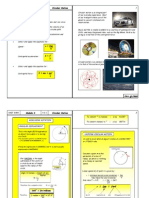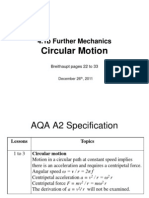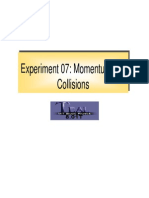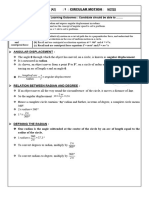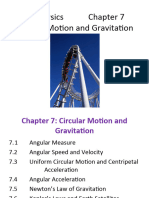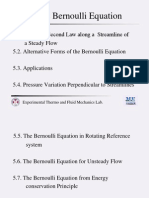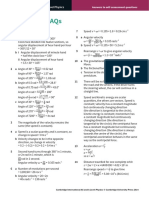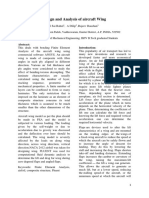5.2 Centripetal Acceleration and Force
5.2 Centripetal Acceleration and Force
Uploaded by
honghong45698Copyright:
Available Formats
5.2 Centripetal Acceleration and Force
5.2 Centripetal Acceleration and Force
Uploaded by
honghong45698Original Title
Copyright
Available Formats
Share this document
Did you find this document useful?
Is this content inappropriate?
Copyright:
Available Formats
5.2 Centripetal Acceleration and Force
5.2 Centripetal Acceleration and Force
Uploaded by
honghong45698Copyright:
Available Formats
5.
2 Centripetal acceleration and force
Centripetal acceleration
Centripetal force Centripetal force experiment
Manhattan Press (H.K.) Ltd.
5.2 Centripetal acceleration and force (SB p. 170)
Centripetal acceleration
Change in velocity (v) = vB vA (represented by QR) Go to Common Error Particle experiences change of velocity (acceleration) along direction AO (pointing to Go to centre of circle) centripetal acceleration Common Error Manhattan Press
2
5.2 Centripetal acceleration and force (SB p. 170)
Centripetal acceleration
An object in uniform circular motion experiences a centripetal acceleration which is the acceleration directed towards the centre of the circle.
Manhattan Press
5.2 Centripetal acceleration and force (SB p. 171)
Centripetal acceleration
v v = v A = vB and = v v = v
Change in velocity v v( ) a= = = = v Time taken t t t
2 v Centripetal acceleration (a ) = v = r 2 = r
pointing to centre of circle
Manhattan Press
Go to
Common Error
4
5.2 Centripetal acceleration and force (SB p. 171)
Centripetal force
Steady speed v but changing direction of motion - force acting on it (Newtons 1st Law) No force in direction of motion (constant speed) Force towards centre of circular path centripetal force (Fc)
Manhattan Press
Go to
Common Error
5
5.2 Centripetal acceleration and force (SB p. 172)
Centripetal force
2 mv Centripetal force ( Fc ) = ma = = mr 2 = mv r
Note: For a uniform circular motion: 1. Centripetal force is always perpendicular to the motion of the body. It does no work on the body and the kinetic energy of the body remains unchanged.
Manhattan Press
6
5.2 Centripetal acceleration and force (SB p. 172)
Centripetal force
Note: 2. The centripetal force (Fc) is the force required to keep the body moving in a circle. It is provided by the external resultant force towards the centre. It is a functional name rather than a real force. The origins of the centripetal forces may be tension, friction or reaction forces.
Manhattan Press
5.2 Centripetal acceleration and force (SB p. 172)
Centripetal force experiment
1. Procedure - rubber bung whirled around in horizontal circle - measure time taken for 50 revolutions of bung - calculate angular velocity ()
Manhattan Press
5.2 Centripetal acceleration and force (SB p. 173)
Centripetal force experiment
2. Analysis T cos = mg .......................... (1) T sin = mr2 .......................... (2) T sin = m ( sin) 2 T = m2 T is provided by Mg Fc = mr2
Manhattan Press
9
5.2 Centripetal acceleration and force (SB p. 173)
Centripetal force experiment
3. Error (i) there is a friction acting at the opening of the glass tube, (ii) the string is not inextensible, (iii) the rubber bung is not whirled with constant speed, and (iv) the rubber bung is not whirled in a horizontal circle.
Manhattan Press
Go to
Example 3
Go to
Example 4
10
End
Manhattan Press
11
5.2 Centripetal acceleration and force (SB p. 170)
When a particle moves in uniform circular motion, it has constant speed but not constant velocity because its direction changes from time to time.
Return to
Manhattan Press
Text
12
5.2 Centripetal acceleration and force (SB p. 170)
Uniform circular motion is not a kind of uniformly accelerated motion since the acceleration is fixed only in magnitude, but not in direction.
Return to
Manhattan Press
Text
13
5.2 Centripetal acceleration and force (SB p. 171)
As centripetal acceleration (a) may be expressed as a = v 2 r 1 a It is wrong to think that r Since velocity is not a constant and v r. Therefore,
2 2 v r a= r r ar
Return to
Text
Centripetal acceleration is actually increased with radius r.
Manhattan Press
14
5.2 Centripetal acceleration and force (SB p. 171)
The circular motion does not produce a centripetal force. The fact is that the centripetal force that causes the circular motion is actually a resultant of other forces.
Return to
Text
Manhattan Press
15
5.2 Centripetal acceleration and force (SB p. 173)
Q: (a) In the centripetal force experiment mentioned above, what will happen when the string breaks while the bung is whirling? (b) What is the relationship between the vertical angle of the string and the speed of the bung? (c) Explain with the aid of a diagram, why a mass at the end of a light inelastic string cannot be whirled in circle in air with the string horizontal. Solution
Manhattan Press
16
5.2 Centripetal acceleration and force (SB p. 174)
Solution: (a) If the string breaks, the centripetal force disappears. The bung can no longer keep in the circular motion. It will fly away tangentially.
2 mv (b) Horizontal motion : Tsin = ...................(1) r Vertical motion : Tcos = mg .....................(2) 2 v (1) (2) : tan = gr
The angle increases as the bung is whirled at a higher speed. Go to
More to Know 1
Manhattan Press
17
5.2 Centripetal acceleration and force (SB p. 174)
Solution (contd): (c) If the string is horizontal (Fig. (a)), there is no vertical force to balance the weight of the mass mg. Therefore, the string must make an angle with the vertical (Fig. (b)) so that the vertical component of T counteracts the weight mg. T cos = mg
Fig. (a) Manhattan Press
Fig. (b)
Return to
Text
18
5.2 Centripetal acceleration and force (SB p. 174)
v 2 = 2r 1. The equation tan = gr g is very useful in answering questions about circular motion. 2. The vertical angle is independent of the mass m. 3. A specific vertical angle is ideal for one speed only.
Return to
Manhattan Press
Text
19
5.2 Centripetal acceleration and force (SB p. 174)
Q: (a) A pendulum bob moves in a horizontal circle with constant angular velocity as shown in the figure. Find, in terms of m, , and g, (i) the centripetal force acting on the bob, (ii) the tension T in the string, and (iii) the angle .
Manhattan Press
20
5.2 Centripetal acceleration and force (SB p. 175)
Q: (b) A student suggests that the value of g can be determined by measuring the period t of the revolution of the bob for various values of . (i) Find an expression for t in terms of , g and . (ii) Suggest a graph which could be used to obtain the value of g. (iii) Discuss critically whether this is a good method for the determination of g.
Solution
Manhattan Press
21
5.2 Centripetal acceleration and force (SB p. 175)
Solution : (a) (i) Centripetal force (Fc) = mr2 = msin 2 (ii) Horizontal component of T, T sin = Fc = msin 2 T = m2 (iii) Vertical component of T, Tcos = mg
cos = mg g = T 2
g = cos 1 2
Manhattan Press
22
5.2 Centripetal acceleration and force (SB p. 175)
Solution (contd) :
g (b) (i) From (a)(iii), = cos Period (t ) = 2 = 2 cos g (ii) Graph of t 2 against cos is plotted. 2 4 cos 2 From (i), t = g 2 2 t 4 Gradient of graph (m) = = cos g 2 4 g= m
(iii) It is not a good method of determining g because it is difficult to maintain the angle at a fixed value, and it is difficult to measure the angle . Return to Manhattan Press
Text
23
You might also like
- Circular MotionDocument7 pagesCircular MotionKupakwashe KampiniNo ratings yet
- Chapter 7-Rotational MotionDocument59 pagesChapter 7-Rotational MotionSuganeya UdiasoorianNo ratings yet
- Applications of Circular MotionDocument3 pagesApplications of Circular Motionmonkey2rockz100% (3)
- Nota Physics Vol 3 Chap 5 (Circular Motion)Document70 pagesNota Physics Vol 3 Chap 5 (Circular Motion)Ernest YapNo ratings yet
- g484 Module 2 4 2 1circular MotionDocument8 pagesg484 Module 2 4 2 1circular Motionapi-236179294No ratings yet
- Dynamics of Uniform Circular Motion: PreviewDocument12 pagesDynamics of Uniform Circular Motion: PreviewEmil NazarenoNo ratings yet
- 08 1 Horizontal and Vertical Circular MotionDocument14 pages08 1 Horizontal and Vertical Circular MotionchaitudscNo ratings yet
- NOTES 5.1 - Circular&HarmonicDocument10 pagesNOTES 5.1 - Circular&Harmonicmehekoy154No ratings yet
- Circular Motion Physics A2-16Document15 pagesCircular Motion Physics A2-16Muhammad ArshadNo ratings yet
- Module 5 HSC Physics NotesDocument8 pagesModule 5 HSC Physics NotesLiam KorngoldNo ratings yet
- A2 41b CircularmotionDocument38 pagesA2 41b CircularmotionHany ElGezawyNo ratings yet
- Formula Sheet: A Cos 2BC C B A C Cos 2AB B A CDocument7 pagesFormula Sheet: A Cos 2BC C B A C Cos 2AB B A CJenny TruongNo ratings yet
- 2ndLE Lecture 23 - R9 Rotational KinematicsDocument28 pages2ndLE Lecture 23 - R9 Rotational KinematicsMark ReyesNo ratings yet
- Experiment 07: Momentum and CollisionsDocument32 pagesExperiment 07: Momentum and CollisionseviroyerNo ratings yet
- Extended Ace SummativeDocument8 pagesExtended Ace Summativeapi-386186057No ratings yet
- Circular Motion and Work EnergyDocument78 pagesCircular Motion and Work EnergyPortia A. EgkenNo ratings yet
- Vibrations 1Document10 pagesVibrations 1boud3No ratings yet
- Complete Answer Guide for Physics for Scientists and Engineers 3rd Edition Knight Solutions ManualDocument70 pagesComplete Answer Guide for Physics for Scientists and Engineers 3rd Edition Knight Solutions Manualtumsinag100% (3)
- Chapter - 2: Dynamic Force AnalysisDocument39 pagesChapter - 2: Dynamic Force AnalysisMohammed ImranNo ratings yet
- Circular Motion - A2Document4 pagesCircular Motion - A2Shaikh Usman AiNo ratings yet
- Lab Session 2Document7 pagesLab Session 2usamaNo ratings yet
- Centrifugal ForceDocument9 pagesCentrifugal ForcecataiceNo ratings yet
- Circular MotionDocument19 pagesCircular MotionMehboob AlamNo ratings yet
- Linear Motion vs. Rotational MotionDocument24 pagesLinear Motion vs. Rotational MotionSai DeepakNo ratings yet
- Lecture 19Document36 pagesLecture 19castles15No ratings yet
- Circular and Rotational MotionDocument11 pagesCircular and Rotational MotionA AnuragNo ratings yet
- Chapter 5 - NotesDocument5 pagesChapter 5 - NotesHywi1No ratings yet
- AP CH 7 PP - TeacherDocument91 pagesAP CH 7 PP - TeacherDianeNo ratings yet
- Circular MotionDocument12 pagesCircular MotionWendy TangNo ratings yet
- 2ndLE Lecture 23 and Recit Review - R9 Rotational KinematicsDocument22 pages2ndLE Lecture 23 and Recit Review - R9 Rotational KinematicsLeanna DaneNo ratings yet
- D II: M P: Conceptual QuestionsDocument41 pagesD II: M P: Conceptual Questionsmazon jackNo ratings yet
- 2 Circular Motion - PDFDocument38 pages2 Circular Motion - PDFAstha PanditNo ratings yet
- Rotational Kinematics Worksheet PacketDocument12 pagesRotational Kinematics Worksheet PacketAbraham RobinsonNo ratings yet
- Chapter-3 (Newton Laws of Motion & Circular) - 220717 - 215603Document14 pagesChapter-3 (Newton Laws of Motion & Circular) - 220717 - 215603ac0227483No ratings yet
- Rotational Motion NotesDocument9 pagesRotational Motion NotesTvissha GoelNo ratings yet
- Lection 4 (Eng) PDFDocument13 pagesLection 4 (Eng) PDFa320neoNo ratings yet
- A2 H 41b CircularmotionDocument31 pagesA2 H 41b CircularmotionHany ElGezawyNo ratings yet
- DOM Unit-IDocument48 pagesDOM Unit-IRamanathan DuraiNo ratings yet
- Ch09 SSM 070904Document26 pagesCh09 SSM 070904VinhTranNo ratings yet
- 5 CircularDocument13 pages5 Circulararies john mendrezNo ratings yet
- Phys124s10 hw02Document5 pagesPhys124s10 hw02snyderbl2100% (1)
- Vibrations 2Document11 pagesVibrations 2boud3No ratings yet
- MIT16 07F09 Lec23Document7 pagesMIT16 07F09 Lec23kapilkumar18No ratings yet
- Chapter 6 Notes Circular Motion and GravityDocument7 pagesChapter 6 Notes Circular Motion and GravityChee K Wong100% (1)
- Career Point Sample - 1 PDFDocument14 pagesCareer Point Sample - 1 PDFShalini KureelNo ratings yet
- BernoulliDocument33 pagesBernoulliabderrahimn100% (1)
- 3-Kinematics - NotesDocument10 pages3-Kinematics - Notesnabiha137100% (1)
- PHY 101 Lecture 3Document43 pagesPHY 101 Lecture 3johnbello1357No ratings yet
- Chapter 5 HW SetAKDocument23 pagesChapter 5 HW SetAKYoojin KimNo ratings yet
- Question Bank GovernorsDocument11 pagesQuestion Bank GovernorsAnil KumarNo ratings yet
- HW-8 - CHDocument20 pagesHW-8 - CHMuzamil Shah0% (1)
- Forced VortexDocument5 pagesForced VortexVrushiket Patil75% (4)
- ExperimentDocument9 pagesExperimentMajdy gamingNo ratings yet
- PHY 400 - Chapter 6 - Rotational MotionDocument30 pagesPHY 400 - Chapter 6 - Rotational MotionJacob OrtizNo ratings yet
- Problem Set 10: Two-Dimensional Rotational and Translational Motion SolutionsDocument11 pagesProblem Set 10: Two-Dimensional Rotational and Translational Motion SolutionsanitaNo ratings yet
- Answers To Saqs: Cambridge International A Level PhysicsDocument2 pagesAnswers To Saqs: Cambridge International A Level Physicsharshanauoc100% (1)
- Numerical Simulation of The Hydrodynamic Performance of An Unsymmetrical Flapping Caudal FinDocument9 pagesNumerical Simulation of The Hydrodynamic Performance of An Unsymmetrical Flapping Caudal Fin이동근No ratings yet
- General Physics ReviewerDocument8 pagesGeneral Physics ReviewerXyrell Claude Monta100% (4)
- CH 05Document28 pagesCH 05api-96362001No ratings yet
- Wilo PumpcurvesDocument25 pagesWilo PumpcurvesSkylarNo ratings yet
- PH141 Recommended Problems Chapt.10 EvenDocument3 pagesPH141 Recommended Problems Chapt.10 Evennomio12No ratings yet
- Dynamics 1:: SolutionDocument3 pagesDynamics 1:: SolutionJamael AbulaisNo ratings yet
- Physics 1 ST Sem Study AnsDocument14 pagesPhysics 1 ST Sem Study AnsJoyce ChoiNo ratings yet
- Airfoil Selection, RoyDocument29 pagesAirfoil Selection, RoyMohammadhossein NirooeiNo ratings yet
- Orifice PlateDocument14 pagesOrifice PlateAyoun Ul HaqueNo ratings yet
- Choke Sizing: Single Phase FlowDocument6 pagesChoke Sizing: Single Phase FlowFrancesco ColellaNo ratings yet
- Flow Over A CylinderDocument14 pagesFlow Over A CylinderHariVathsalaNo ratings yet
- Pressure Distribution, Lift and Drag On An Airfoil: MECH 345: Mechanics of Fluids I Experiment #4Document4 pagesPressure Distribution, Lift and Drag On An Airfoil: MECH 345: Mechanics of Fluids I Experiment #4Js SmithNo ratings yet
- Double Suction Centrifugal PumpDocument8 pagesDouble Suction Centrifugal PumpBilal WaseemNo ratings yet
- Physics 71Document9 pagesPhysics 71nik-koNo ratings yet
- Design and Analysis of Aircraft WingDocument7 pagesDesign and Analysis of Aircraft WingSai RahulNo ratings yet
- Lec-2specific Enrgy-Rapidly Varying Flow PDFDocument133 pagesLec-2specific Enrgy-Rapidly Varying Flow PDFNoman Tariq Malkani100% (1)
- Notes (Compressible Flow)Document20 pagesNotes (Compressible Flow)rbnallamothu100% (1)
- Open Channel ReportDocument6 pagesOpen Channel ReportFearless HeroNo ratings yet
- Coiled TubingT Downhole Hydraulics OS-HPCT-D010Document17 pagesCoiled TubingT Downhole Hydraulics OS-HPCT-D010Amina MekkakiaNo ratings yet
- Aerodynamics-II Part B QuestionsDocument7 pagesAerodynamics-II Part B QuestionsAeronaughtycs Hamdan100% (1)
- Drag Coefficients of Variously Shaped Solid Particles: Theoretical Foundations of Chemical Engineering June 2011Document38 pagesDrag Coefficients of Variously Shaped Solid Particles: Theoretical Foundations of Chemical Engineering June 2011aminNo ratings yet
- Falling Ball ViscometerDocument5 pagesFalling Ball ViscometerAbdullah AhmadNo ratings yet
- Me2305 Applied Hydraulics and Pneumatics L T P CDocument1 pageMe2305 Applied Hydraulics and Pneumatics L T P CprakashmenmoliNo ratings yet
- Zun Sheng Phang Production Logging InterretationDocument50 pagesZun Sheng Phang Production Logging InterretationZachary Phang Zun ShengNo ratings yet
- Physics: Edexcel GCEDocument5 pagesPhysics: Edexcel GCEAbdulrahman JijawiNo ratings yet
- DRB Urm PDFDocument1 pageDRB Urm PDFShang Divina EbradaNo ratings yet
- MIT ProblemsDocument29 pagesMIT ProblemsDe Nicolas JaidarNo ratings yet
- Annezasofia - Asg Chap 3Document12 pagesAnnezasofia - Asg Chap 3anneza sofiaNo ratings yet
- Velocity and WC Chart PDFDocument2 pagesVelocity and WC Chart PDFAbdul HaseebNo ratings yet
- ATPL Mass and Balance FormulasDocument1 pageATPL Mass and Balance FormulasPhil100% (2)
- Power Zone Equipment - NPSH Calculator ResultDocument2 pagesPower Zone Equipment - NPSH Calculator ResultMd. Mominul IslamNo ratings yet
- MEP Rusun YogyaDocument19 pagesMEP Rusun Yogyasetiyo pambudi100% (1)
- Open Ended PrintDocument14 pagesOpen Ended PrintSalleh SaidNo ratings yet




